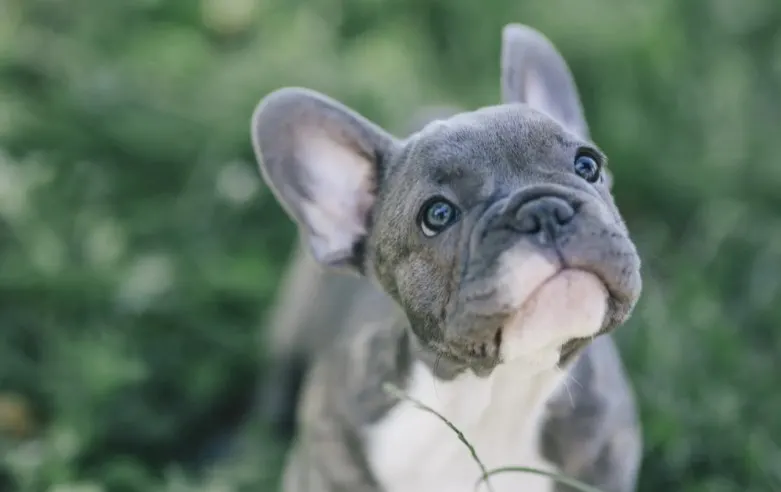The French Bulldog or Bulldog Frances as some people like to call them, is in the top five most popular dogs in the US, according to the AKC. This breed is a Bulldog but a miniature version!
These puppies have a very interesting look to them, but their little bat ears are their trademark! They are very adaptable and can live with anyone! Singles, couples, families with children, other pets! But sadly they come with a fair share of health problems.
It’s these traits (but also many more) that make the French Bulldog the perfect dog for anyone!

You can read more about Frenchies:
- Baby And French Bulldog: How To Make It Work
- How many puppies do French Bulldogs have?
- Long Haired French Bulldog
- Boston Terrier VS French Bulldog
- Fluffy French Bulldog: Complete Breed Info
French Bulldog – Breed information
Bulldogs are originally from England and they used to be courageous and aggressive hunting dogs. When dog fighting was banned in England in the 19th century, the demand for fighting dogs went down the drain too.
The French Bulldog originated in English cities as a toy-sized variant of the Bulldog. The breed was popular among Nottingham lace workers, and when many lace workers went to France for greater chances, they naturally brought their small bulldogs, their pet Bulldogs with them turning them into French imports.
The French Bulldog flourished in France and Europe, and his allure was quickly discovered by Americans. In 1896, the first French Bulldog was seen in the United States at the Westminster Kennel Club exhibition. The breed was rapidly called “Frenchie,” and the name is still used affectionately today.
Fun fact: This dog was originally known as the Boule-Dog Francais, but the English later sneered at the concept of naming an English canine a French name.
After that, a small number of Bulldogs were brought to France and introduces as perfect dogs for catching mice. Soon, the rich and famous started to like these dogs, but they wanted a smaller version of them. That’s when other breeds such as Pugs and Terriers were crossbred with the Bulldog and the French Bulldog came to life. In 1836 the so-called “Toy Bulldog” or miniature Bulldog appeared for the first time at a dog show in London.
It was now so different from the English Bulldog that the French Bulldog or Bulldog Frances became a separate breed. The French Bulldog experienced an absolute peak of popularity around the turn of the 20th century when King Edward VII got one too! Back then they were mostly owned by the high society, specifically society ladies. They were also the ones who first displayed them at the Westminster Kennel Club Dog Show in the nineteenth century!
Physical characteristics – How big do they get?
With its short, stocky build, The French Bulldog has a muscular and stocky build. They are short and compact. So you can say they belong to the smaller-sized breeds growing about 11 to 12 inches tall making them a great pet for city dwellers and apartment dwellers because they don´t take up much space. When it comes to their weight, males weigh 20 to 28 pounds, and females 16 to 24 pounds.
One of their recognizable features is their large, erect large bat ears that have a triangular shape and are positioned above the angular head. We also love them for their characteristic short nose and short tail. If you look at French Bulldog breed pictures those are the first two things you will notice!
Except for the wrinkled skin around their face and shoulders, they have a small, compact frame that is well proportioned and rather strong and despite their size, they make surprisingly good watchdogs.
Their shiny fur doesn’t have an undercoat and they can be a variety of breed colors such as black or white, fawn-colored, cream, or dark brindle. They can also have brindle markings, white markings, or black masks. They have distinctive dark brown eyes and a cute “squished up” face. Their silky, lustrous coats just need to be brushed on occasion to maintain cleanliness, and they shed a moderate quantity.
Temperament
Dogs’ personalities are influenced by their surroundings as much as their heredity. While certain canine traits can be generalized and patterns are drawn, each dog is unique. The truth is that their personality is influenced by a variety of factors, including their parents’ temperament and dispositions, their upbringing, breeding, and the amount of training they had as puppies. The developing years of a dog are crucial since it is these years that shape their personalities and temperaments in adulthood.
As mentioned above, Bulldog Frances is very affectionate and loyal. They love to spend a lot of time with their family. If you’re very busy and know that you’ll have to leave your dog alone for long periods, maybe the Frenchie isn’t for you.
The affectionate Frenchie is a calm house dog who enjoys being the center of attention. He insists on it! Because he may fight for your attention with other members of the family, this dog is best suited for a single-person household. The French bulldog does not bark frequently, only when he is excited.
This breed will thrive with an owner who spends a lot of time at home, for example, if you work from home. They’ll enjoy just lying next to your feet while you work. They will probably also follow you from room to room. That’s how much they love being around their owners!
Mischievous dogs
Frenchies tend to be a bit mischievous, so they need an owner who will be consistent, firm, and be patient with them. While we´re talking about patience, training them will also require a little patience because the dogs tend to be stubborn. But compared to other dogs they are on the easier side to train.
Besides this, they are also very smart and will learn very quickly making them a great option for almost everyone! That is as long as you make it seem like a game and keep it fun! Even though they don’t need a lot of exercises, to keep their weight under control daily walks are advisable.
Health issues of the French Bulldog
There are a few illnesses that the French Bulldog is susceptible to. It doesn’t mean that every Frenchie will get these diseases, but you should still be aware of them.
Allergies: Allergies are very common among dogs. There are three types of allergies you should look out for:
- Food-based allergies – treated by an elimination process of certain foods from the dog’s diet.
- Contact allergies – caused by a reaction to a topical substance such as bedding, flea powders, dog shampoos, and other chemicals, and treated by removing the cause of the allergy
- Inhalant allergies – caused by airborne allergens such as pollen, dust, and mildew.
- Patellar Luxation: This is also called “slipped stifles” and it’s a very common problem in small dogs. Patellar Luxation happens when the patella is not properly lined up and slips in and out of place. This causes lameness or an abnormal gait in dogs.
- Hip Dysplasia – the most common hereditary disorder among dogs. With this condition, the femur does not fit snugly into the hip joint’s pelvic socket. Hip dysplasia can be present with or without clinical symptoms. Some dogs have pain and lameness in one or both of their back legs. Arthritis might occur as the dog ages. Dogs with Hip dysplasia should not be bred, that’s why good breeders do health screenings on their dogs. That way they make sure that their dogs don’t carry this condition. Inquire with the breeder for documentation that the parents have been checked for hip dysplasia and determined to be healthy.
Besides these, the Bulldog Frances tends to get the following diseases too:
- Brachycephalic Syndrome – dogs with short heads, restricted noses, or elongated or soft palates are prone to this condition. Their airways are clogged to varying degrees, resulting in everything from noisy or laborious breathing to complete airway collapse. Snuffling and snorting are typical in dogs with the brachycephalic condition. Depending on the severity of the illness, treatment may include oxygen therapy as well as surgery to expand nostrils or shorten palates.
- Hemivertebrae – a vertebral deformity in which one or more vertebrae are formed like a wedge or triangle. This abnormality can develop by itself or in conjunction with other vertebral deformities. Hemivertebra can be painless or impose pressure on the spinal cord. This can result in pain, weakness, or paralysis. Unless there is spinal cord pressure, there is no treatment for the problem.

- Intervertebral Disc Disease (IVDD) – when a disc in the spine ruptures or herniates, it pushes upward into the spinal cord, causing IDD. When the disc pushes onto the spinal cord, nerve transmissions along the spinal cord are impeded. Intervertebral Disc Disease can be caused by trauma, aging, or just the physical jolt caused when a dog leaps off a sofa. When a disc ruptures, the dog typically experiences discomfort, and the ruptured disc might result in weakness and temporary or permanent paralysis. Nonsteroidal anti-inflammatory medications (NSAIDs) designed specifically for dogs are typically used in treatment.
The following three health problems are quite common too:
- Von Willebrand’s Disease – this is a type of blood condition that can affect both humans and dogs. It affects the clotting process it takes a much longer time for the blood to clot. Von Willebrand’s disease symptoms include nasal bleeds, bleeding gums, prolonged bleeding after surgery, and prolonged bleeding during heat cycles or after whelping. Blood is occasionally detected in the stool. This condition is usually diagnosed between the ages of 3 and 5 in your dog and cannot be cured. It can, however, be treated with treatments such as cauterizing or suturing injuries, infusions of the von Willebrand factor before surgery, and avoiding certain medicines. It´s a very serious disease that can be fatal.
- Cleft Palate – The palate serves as the roof of the mouth, separating the nasal and oral cavities. It is divided into two parts: hard and soft. A cleft palate is characterized by a slit that can run bilaterally or unilaterally and can range in size from a small hole to a huge slit. A cleft palate can affect both the hard and soft palates independently or jointly, and it can result in a cleft lip. Puppies can be born with cleft palates, or they can develop one as a result of an injury. Cleft palates are fairly common in dogs, however many puppies born with one do not survive or are destroyed by their breeder.
- Elongated Soft Palate – the soft palate is an extension of the mouth’s roof. When the soft palate is extended, it can clog the airways and make breathing difficult. Elongated Soft Palate is treated surgically by removing the extra palate.
What is the genuine cost of a French Bulldog?
If you do some research, you’ll discover that French Bulldogs can cost up to $8,000. That may be true in some locations and for certain breeders, but it is not always the case. If your breeder is seeking $8,000, the parents are likely to be Champion parents. This signifies that both of the puppy’s parents have won championships in conformation shows.
However, the typical price of a French Bulldog in the United States is between $1,500 and $3,000. So, while you are not required to pay $8,000, they are still costly. You will have to pay the above-mentioned sum if you want a pure-bred puppy with good papers.

You may be able to find a breeder who is willing to accept a lower price. However, please ensure that they are reliable and that you can trust them. You’d be shocked how many breeders are only interested in making a buck and will sell you a sick puppy.
A French Bulldog costs between $1,500 and $3,000 on average in the United States.
So, if someone offers you $800 for a Frenchie, it’s probable they’re selling you a puppy with a concealed ailment. You’ll have to pay all of the money you thought you saved by buying from a shady breeder for your puppy’s vet and medications.
Please investigate how the breeder treats the dogs and whether they are truly healthy. To be cautious, you should Google the breeder or perhaps visit them once or twice to get to know them better. Inquire about the parent animals; they should be in good health and their kennel should be clean. It is equally critical not to purchase animals from puppy mills or puppy farms.
Now, if you´re wondering why they cost so much, well the price is caused by the fact that these dogs are bred by artificial insemination. It is not easy for Frenchies to conceive and give birth. To give birth, French Bulldogs require artificial insemination and, in many cases, a Caesarean operation. This is because they are so small and have so many health issues.
Conclusion – French Bulldog
In short, the Bulldog Frances is a great dog and companionable breed. Sure, they might look a bit funny, but beauty is in the eye of the beholder, right? Besides their special looks, the Frenchie is a dog with many qualities.
If you want a pet who will be loyal and always by your side, the Frenchie is the perfect dog for you! They hate being left alone and thrive on their owner’s attention and love. They are also low maintenance because they don´t need much exercise.
Frenchies make great pets. They are loving companions who thrive on human contact, so you won’t ever feel lonely! And in addition to that their brilliant coat doesn´t require much grooming! But, they do drool quite a bit, so if a little drool is bothering you, then this dog might not be for you.
The French Bulldog is also for those of you who want a dog that can be registered in kennel clubs and a dog registry! they are accepted by several organizations including American Canine Association Inc., American Kennel Club, Dog Registry of America, Inc., Fédération Cynologique Internationale, and others. They are recognized by kennel clubs all over the world including the United Kingdom and the whole of Europe. If you need more info on this breed you can always check out their National breed club or French Bull Dog Club of America which is the oldest club for this breed.
While you’re here read more about the French Bulldog colors:

